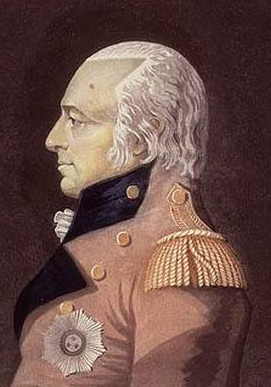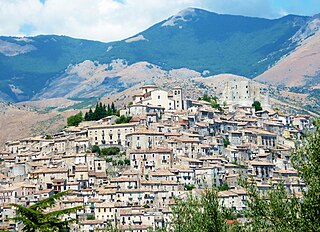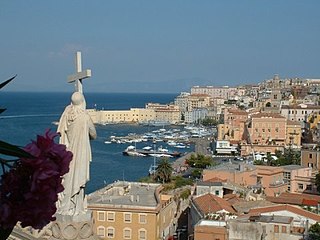Related Research Articles

Ferdinand I was the King of the Two Sicilies from 1816, after his restoration following victory in the Napoleonic Wars. Before that he had been, since 1759, Ferdinand IV of the Kingdom of Naples and Ferdinand III of the Kingdom of Sicily. He was also King of Gozo. He was deposed twice from the throne of Naples: once by the revolutionary Parthenopean Republic for six months in 1799 and again by Napoleon in 1805, before being restored in 1815.

War of the Third Coalition was a European conflict spanning 1805 to 1806. During the war, France and its client states under Napoleon I opposed an alliance, the Third Coalition, which was made up of the United Kingdom, the Austrian Empire, the Russian Empire, Naples, Sicily, and Sweden. Prussia remained neutral during the war.

The Napoleonic era is a period in the history of France and Europe. It is generally classified as including the fourth and final stage of the French Revolution, the first being the National Assembly, the second being the Legislative Assembly, and the third being the Directory. The Napoleonic era begins roughly with Napoleon Bonaparte's coup d'état, overthrowing the Directory, establishing the French Consulate, and ends during the Hundred Days and his defeat at the Battle of Waterloo. The Congress of Vienna soon set out to restore Europe to pre-French Revolution days. Napoleon brought political stability to a land torn by revolution and war. He made peace with the Roman Catholic Church and reversed the most radical religious policies of the Convention. In 1804 Napoleon promulgated the Civil Code, a revised body of civil law, which also helped stabilize French society. The Civil Code affirmed the political and legal equality of all adult men and established a merit-based society in which individuals advanced in education and employment because of talent rather than birth or social standing. The Civil Code confirmed many of the moderate revolutionary policies of the National Assembly but retracted measures passed by the more radical Convention. The code restored patriarchal authority in the family, for example, by making women and children subservient to male heads of households.

The Battle of Maida, fought on 4 July 1806 was a battle between the British expeditionary force and a French force outside the town of Maida in Calabria, Italy during the Napoleonic Wars. John Stuart led 5,236 Anglo-Sicilian troops to victory over about 5,400 Franco-Italian-Polish troops under the command of French general Jean Reynier, inflicting significant losses while incurring relatively few casualties. Maida is located in the toe of Italy, about 30 kilometres (19 mi) west of Catanzaro.

General Sir James Henry Craig KB was a British military officer and colonial administrator.

The Battle of Campo Tenese saw two divisions of the Imperial French Army of Naples led by Jean Reynier attack the left wing of the Royal Neapolitan Army under Roger de Damas. Though the defenders were protected by field fortifications, a French frontal attack combined with a turning movement rapidly overran the position and routed the Neapolitans with heavy losses. The action occurred at Campotenese, a little mountain village in the municipality of Morano Calabro in the north of Calabria. The battle was fought during the War of the Third Coalition, part of the Napoleonic Wars.

The siege of Gaeta saw the fortress city of Gaeta and its Neapolitan garrison under Louis of Hesse-Philippsthal besieged by an Imperial French corps led by André Masséna. After a prolonged defense in which Hesse was badly wounded, Gaeta surrendered and its garrison was granted generous terms by Masséna.

Sir John Stuart, Count of Maida GCB (1759–1815), was a British Lieutenant-General during the Napoleonic Wars.

François Xavier de Schwarz or François-Xavier-Nicolas Schwartz was born in Baden but joined the French army in 1776. He became a cavalry officer during the French Revolutionary Wars, fighting with the 2nd Hussar Regiment in numerous actions including Jemappes, Fleurus, and Neuwied. After being captured in an abortive invasion of Ireland, he was promoted to command the 5th Hussar Regiment. He led the unit in the War of the Second Coalition, most notably at Hohenlinden and in the subsequent pursuit of the Austrians.
The Army of Naples was a French Army unit which took this name following its capture of Naples in 1799. It was related to the Army of Italy.
Gaspard Amédée Gardanne was a French general who fought in the Napoleonic Wars.
The VIII Corps of the Grande Armée was a French military unit that existed during the Napoleonic Wars. Emperor Napoleon I formed it in 1805 by borrowing divisions from other corps and assigned it to Marshal Édouard Mortier. Marshal André Masséna's Army of Italy was also reorganized as the VIII Corps at the end of the 1805 campaign. The corps was reformed for the 1806 campaign under Mortier and spent the rest of the year mopping up Prussian garrisons in western Germany.

The Invasion of Naples was a front during the War of the Third Coalition, in 1806, when an army of the French Empire led by Marshal André Masséna marched from northern Italy into the Kingdom of Naples, an ally of the Coalition against France ruled by King Ferdinand IV. The Neapolitan army was vanquished at Campo Tenese and rapidly disintegrated. The invasion was eventually successful despite some setbacks, including the prolonged Siege of Gaeta, the British victory at Maida, and a stubborn guerrilla war by the peasantry against the French. Total success eluded the French because Ferdinand withdrew to his domain in Sicily where he was protected by the Royal Navy and a British Army garrison. In 1806 Emperor Napoleon appointed his brother Joseph Bonaparte to rule over southern Italy as king.
The Hanover Expedition, also known as the Weser Expedition, was a British invasion of the Electorate of Hanover during the Napoleonic Wars. Coordinated as part of an attack on France by the nations of the Third Coalition against Napoleon by William Pitt the Younger and Lord Castlereagh, planning began for an invasion of French territories in July 1805. Hanover, previously a British possession, was chosen as the goal of the expedition, with Swedish and Russian forces under Gustav IV Adolf and Alexander Ivanovich Ostermann-Tolstoy brought in to support the endeavour. Key to the success of the invasion was the support of Prussia, a nation poised to threaten France but not as yet openly hostile to the country. Sir George Don commanded the British expedition and he arrived with an army of around 14,000 men at Cuxhaven in November. To bolster the expedition and to strengthen the resolve of Prussia, Don's army was reinforced by 12,000, with Lord Cathcart taking over command.
The Greek Legion, officially the Light Jäger Foot Legion, was a Jäger infantry unit in the service of the Russian-controlled Septinsular Republic. It consisted of soldiers of Greek and Albanian origin and was led by Major-General Emmanouil Papadopoulos. It was active between 1805 and 1807, taking part in the War of the Third Coalition and the Russo-Turkish War (1806–1812).

The 1st Swiss Regiment was a Swiss mercenary line infantry regiment in the French Imperial Army during the Napoleonic Wars. During the expansion of the Imperial Army in 1803, Napoleon decreed the formation of four Swiss mercenary regiments, one of these later becoming the famed 1st Swiss. After a short time serving in Southern Italy, notably serving at the Battle of Maide, the 1st Swiss were sent to Poland for the impending Invasion of Russia. During the invasion, the regiment remained in the reserve, but served with honour, notably at the Battles of Polotsk and later the crossing of the Berezina. After retreating from Russia, elements of the regiment served during the minor campaigns until May 1814. The regiment was then reformed under the Bourbon restored monarchy, and continued into the Royal Guard until its final disbandment in 1830.

The Army of the Kingdom of Naples was the primary land defence and offence force of the Kingdom of Naples. It served alongside Napoleon’s Grande Armée in various campaigns and wars across Europe, until its final demise in the Neapolitan War of 1815. It was in service from 1806 to 1815, reborn from the Army of the Two Sicilies after the annexation of Naples. The Army was more known for the splendour of its uniforms rather than the achievements of its troops.
General Christopher Chowne, born Christopher Tilson and also known as Christopher Tilson-Chowne, was a British Army officer most notable for his service in the Peninsular War. He joined the army in 1788 and after periods of service in the 23rd Regiment of Foot and an Independent Company, he became lieutenant-colonel of the 99th Regiment of Foot in 1794. The 99th were disbanded in 1797, and Chowne joined instead the 44th Regiment of Foot in 1799. He commanded the regiment at the battles of Abukir and Mandora in the British campaign in Egypt in 1801. In 1805 he was appointed a brigadier-general, as which he served in the Anglo-Russian occupation of Naples later in the year and subsequently in the West Indies.
References
- 1 2 3 Saul, Norman E. (1 April 1994). "Counterpoint to Trafalgar: The Anglo-Russian Invasion of Naples, 1805–1806 (review)". The American Historical Review. University of Chicago Press. 99 (2): 545–546. doi:10.1086/ahr/99.2.545.
- ↑ Paoletti, Ciro (2008). A Military History of Italy. Greenwood Publishing Group. pp. 77–78. ISBN 9780275985059 . Retrieved 17 October 2018.
- 1 2 3 4 5 6 Rosenberg, Chaim M. (2017). Losing America, Conquering India: Lord Cornwallis and the Remaking of the British Empire. McFarland. p. 168. ISBN 9781476668123 . Retrieved 18 October 2018.
- ↑ Flayhart, William Henry (1992). Counterpoint to Trafalgar: The Anglo-Russian Invasion of Naples, 1805–1806. Columbia, South Carolina: University of South Carolina Press. p. 93. ISBN 9780585338583.